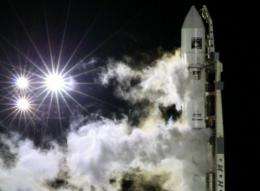Uncertainty grows over Russia Mars probe crash site

Uncertainty about where a doomed Russian Mars probe might crash back to Earth grew Friday when the Roscosmos space agency changed its prediction thousands of miles (kilometres) from the Pacific to the Atlantic Ocean.
Roscosmos said the 13.5-tonne Phobos-Grunt probe would probably begin its fatal descent on Sunday evening Moscow time rather than in the afternoon as initially thought.
This meant that "Phobos-Grunt will enter the atmosphere over Argentina and have its fragments splash down in the Atlantic Ocean," an unnamed space official told the Interfax news agency.
The latest estimate on a Roscosmos graphic showed the $165-million craft splashing down at 8:22 pm (1622 GMT) about 1,000 miles (1,600 kilometres) due south of Buenos Aires -- a spot within geographic proximity of the Falkland Islands.
The previous Roscosmos map released on Thursday had shown fragments of the ill-fated craft coming down between the northwestern shores of Madagascar and the east coast of Africa.
"The change in the time and location of the landing ... is based on the diminishing altitude of the vessel's orbit, solar activity and atmospheric conditions," Roscosmos said.
The unmanned vessel -- stuck in orbit since its November 9 launch -- will be one of the largest objects to re-enter the atmosphere since Russia brought down the Soviet-era Mir space station in 2001.
It is loaded with enough toxic fuel to take it to the mysterious Mars moon Phobos and is weighed down further by a Chinese satellite it had been due to put in orbit around the Red Planet under a landmark deal with Beijing.
Both Roscosmos and US space officials at NASA have made great efforts to downplay the dangers posed by the crashing probe.
The Russian side predicts that only 20 or 30 segments weighing no more than 200 kilogrammes (440 pounds) combined will survive the fiery re-entry and actually hit the Earth's surface.
The chief NASA scientist on orbital space debris meanwhile dismissed the threat posed by the craft's toxic fuel.
Nicholas Johnson said the Russian craft's fuel tanks are made of aluminium rather than the much tougher titanium metal preferred by US space officials.
"According to Mr. Johnson, aluminium has a lower melting point than titanium and that significantly reduces the chances of the propellant reaching the surface of the Earth," NASA reported on its website.
But Russia's past inability to locate its own vessels and subsequent admission that it will not be able to steer Phobos-Grunt upon its return has raised some concern about how the descent might unfold.
The complex Roscosmos diagram shows the craft potentially crashing at any point on Earth south of London and north of the southernmost tip of New Zealand.
Roscosmos said it will be keeping both the United Nations "and interested countries on whose territory the Phobos-Grunt probe's fragments might fall" informed with regular updates.
The ambitious project had initially aimed to revive Russia's interplanetary programme and prepare the way for a manned mission to Mars.
But it instantly came to represent one of the more high-profile mishaps in a year littered with unprecedented setbacks in the Russian space programme.
The November accident struck less than three months after an unmanned Progress supply ship bound for the International Space Station crashed into Siberia.
Russia also lost three navigation satellites as well as an advanced military satellite and a telecommunications satellite in the past year.
(c) 2012 AFP





















